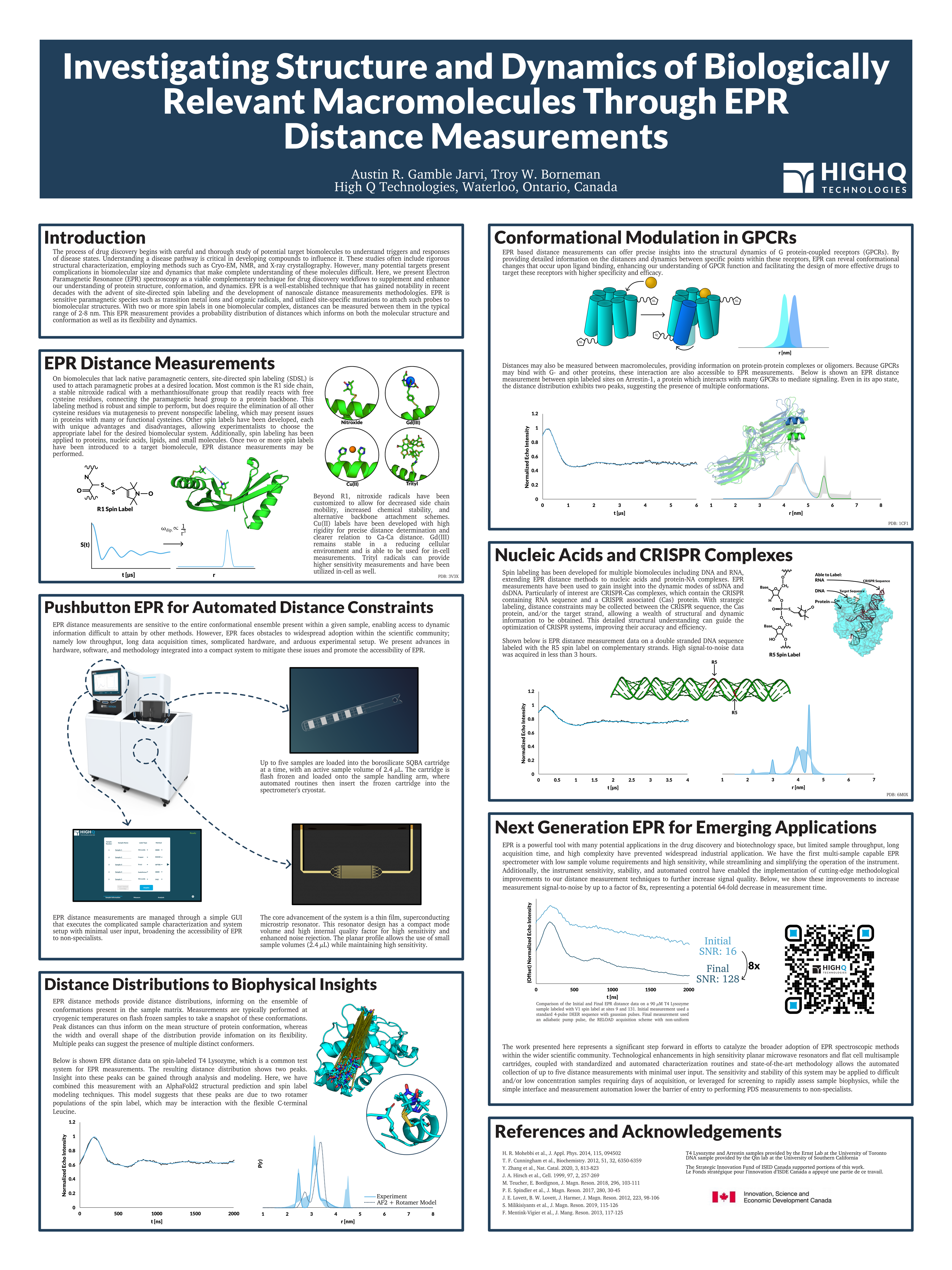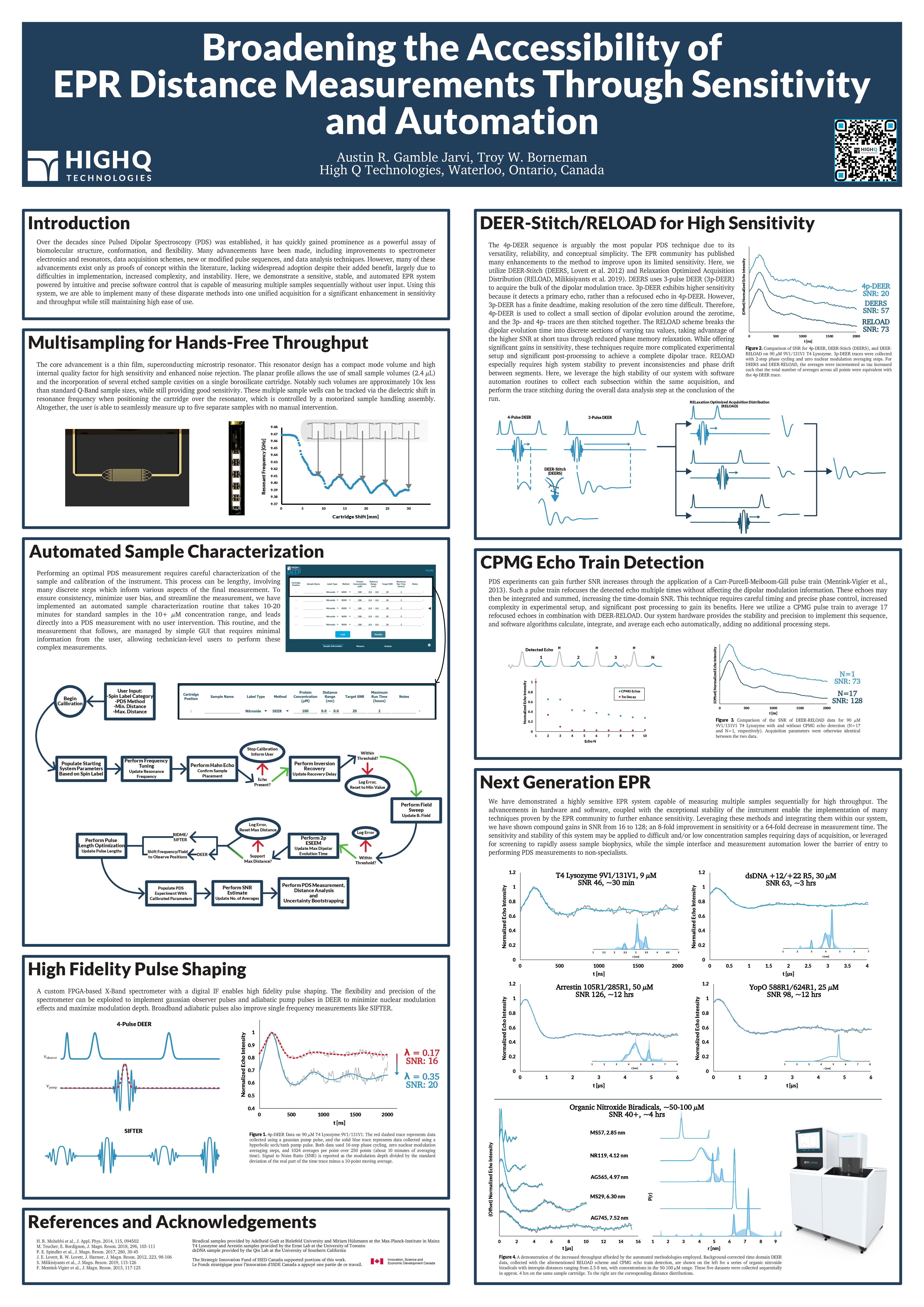
Scientific Publications
High Q Publications:
Investigating Structure and Dynamics of Biologically Relevant Macromolecules Through EPR Distance Measurements
Gamble Jarvi, A. & Borneman, T. Investigating Structure and Dynamics of Biologically Relevant Macromolecules Through EPR Distance Measurements. Discovery on Target (2024).
Abstract: Here we present Electron Paramagnetic Resonance (EPR) based distance measurements as a powerful method to gain fine structural and dynamic information on a wide range of biomolecules of interest to drug discovery. We also present advancements in EPR hardware, software, and methodology that increase sensitivity and boost throughput, representing significant progress in fostering the adoption of EPR spectroscopic techniques into the pharmaceutical and biotechnology workflows.
Broadening the Accessibility of EPR Distance Measurements Through Sensitivity and Automation
Gamble Jarvi, A. & Borneman, T. Broadening the Accessibility of EPR Distance Measurements Through Sensitivity and Automation. The XIIth Conference of the European Federation of EPR groups (2024).
Abstract: Electron Paramagnetic Resonance (EPR) spectroscopy has contributed greatly to structural biology in recent years, providing valuable biophysical information on relevant macromolecules. EPR-based distance measurements are particularly useful in this field, providing point-to-point distance distributions that enable insight into biomolecular dynamics – information that can be difficult to ascertain with other standard methods. However, EPR is often underutilized in structural biology workflows, attributed in part to complicated experimental setup procedures requiring expert users, intricate hardware, and long data acquisition times, all of which contribute to low throughput. Here, we present advancements in EPR hardware, software, and methodology that mitigate these factors.
These advancements are enabled primarily through the implementation of a sensitive superconducting microwave resonator suitable for biological samples. The small form factor of the resonator allows for robust multi-sampling. Combined with the development of automated sample characterization, experiment setup, and data analysis routines, multiple EPR distance measurements may be collected sequentially without additional user input. These routines require only basic sample information, lowering the barrier of entry to perform such measurements. Furthermore, we demonstrate the incorporation and automation of efficient data acquisition schemes to increase sensitivity and minimize signal averaging time. Taken together, this work presents an efficient EPR system enabling increased distance measurement throughput and accessibility to non-specialist users.
Going the Extra Nanometer: Leveraging Software and Hardware Automation to Maximize Distance Measurement Efficiency
Gamble Jarvi, A. & Borneman, T. Going the Extra Nanometer: Leveraging Software and Hardware Automation to Maximize Distance Measurement Efficiency. 45th International EPR Symposium (2024).
Abstract: Since their initial development nearly three decades ago, nanoscale distance measurement methods remain an important and powerful class of pulsed electron paramagnetic resonance (EPR) spectroscopic techniques. Providing probability distributions of the distance between two or more paramagnetic centers, such techniques have broadened the scope of EPR applications, finding particular relevance for the study of complex biological samples such as membrane proteins, protein-protein and protein-nucleic acid complexes, metalloproteins, and highly dynamic biomolecules. The most common among these distance techniques, the Double Electron Electron Resonance (DEER) sequence, is robust, conceptually simple, and well-studied, making it the foremost choice for appropriate samples. Significant effort within the field has been exerted to improve the efficiency of such distance measurements, and DEER specifically. Advancements in hardware, pulse sequences, and data acquisition schemes can lead to significant gains in sensitivity. However, many of these examples rely on additional experimental setup and/or manual post-processing, and have not been widely adopted. Herein, we present the incorporation and automation of several enhancements to the typical DEER experiment, in addition to sample handling and characterization routines, enabled by a custom hardware and software platform. These enhancements increase technique throughput and sensitivity while removing complicated pre- and post- experiment work from the end user. Such efforts present a step forward in broadening not only the applications, but the accessibility of EPR as a technique, enabling simplified setup and processing for non-expert users.
Advancements in EPR Technology and Methodology Enhance Sensitivity and Throughput
Gamble Jarvi, A. & Borneman, T. Advancements in EPR Technology and Methodology Enhance Sensitivity and Throughput. Biophysical Society (2024).
Abstract: Electron Paramagnetic Resonance (EPR) spectroscopy is a well-established and powerful tool for elucidating biophysical information in a wide range of biological systems. The ability to perform high sensitivity nanoscale EPR distance measurements has revolutionized the applicability of the method, enabling the determination of point-to-point constraints within biomolecules that are often difficult to study through other methods. EPR measurements of a wide variety of low concentration biological samples are now possible, including membrane proteins, protein assemblies, and flexible macromolecules. Widespread adoption of EPR for biophysical applications has been limited, however, due to complicated hardware, elaborate and time-consuming experimental setup, and the necessity of long data acquisition times for sufficient signal-to-noise (SNR) at biologically relevant concentrations. We present innovations in the science, engineering, and methodology of EPR spectroscopy that enable automated collection of high SNR distance data on sub-10 µM protein samples of 2.4 µL volume in under two hours, effectively eliminating or mitigating the drawbacks of the method. The presented advancements represent a significant step forward in broadening the accessibility of EPR techniques to the scientific community.




